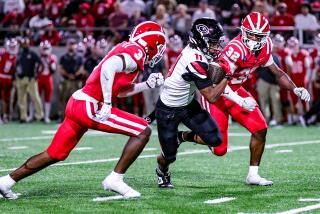Taylorâs Teams Out of Running Room at Sherman Indian
RIVERSIDE â The Sherman Museum on the campus of Sherman Indian High School here is probably smaller than most repositories, but it is a history lesson at every turn, a home to numerous tribal artifacts, a trophy case of Indian lore.
The building, erected in 1902, is included in the national register of historic places and, like the school itself, is named after James Schoolcraft Sherman, who in the early 1900s served in the House of Representatives and as chairman of the Department of Indian Affairs.
The museum houses collections of arrowheads, beadwork, pottery and tomahawks. One room, with hanging photographs of Associated Student Body presidents from 1938 to the present, is still used as a small lecture hall and reference library.
But there is a small partitioned area of the museum that stands apart from the rest, and not just because of the 6 1/2-foot high papier-mache reproduction of James Earle Fraserâs sculpture, âEnd of the Trail,â which depicts a weary Indian astride a weary horse. This cramped space houses the sports history of Sherman Indian, and that lore goes back a long way, too.
There are pictures and banners, plaques and loving cups. The oldest trophy is from 1912, so worn and tarnished that itâs hard to tell exactly what itâs for. There is another dated 1915, from something called the Corona marathon. Some are from recent years, but the older ones dominate.
That figures to change real soon, though. Ken Taylor has said he wants to move some of his teamâs awards to Sherman Museum, and there are plenty from his 11 years as one of the most successful cross-country coaches in California.
Some say he is one of the best in the nation. The Harrier magazine, which covers the national and international cross-country scene, said that recently when it named Sherman Indian among the top 50 high school teams in the country last year. Small school or large, how many coaches can say they have lost just one dual meet since 1974?
Without ever having had a Southern Section individual champion, Taylor can, and thatâs why he has the space problem. Thereâs just too much hardware to put in one trophy case in the hallway of one of the main buildings: 1-A team championships in 1975, â80, â82, â83, â84, and runner-up in â79; a 2-A title in â76 and runner-up in â77 for the two seasons the Braves moved up a division. They also have another 1-A championship in 1973, the year before Taylor arrived.
That level of success doesnât figure to stop soon, either. Going into todayâs prestigious Mt. San Antonio College Invitational at Mt. San Antonio College in Walnut, a two-day event, Sherman Indian is the top-ranked 1-A team, just as it has been since the start of the season. The boysâ frosh-soph race will begin at 2:30, followed by the varsity at 3 and the girlsâ race at 3:30.
Just how do the Braves get such continuous positive results?
The Hopis, Papagos, Pimas and Apaches, who make up the majority of the 1985 team, come from reservations in Arizona; the Navajos from New Mexico; the Chickasaws from Oklahoma. They all come together at the 600-student boarding school whose running coach is a full-blooded Creek from Oklahoma.
âIf theyâre on a reservation, and thatâs where most of these kids came from, thereâs not a whole lot to do,â Taylor said. âAt night, they have no pool hall to go to, no beach to go to. So they have to initiate their own activities.â
Often, that activity is long-distance running. At Sherman Indian, few things are encouraged more.
Itâs a place where students are among their own, with 19 tribes represented in all. Most students are here because of financial hardships or because they were unable to get along in other schools. Some are from as far away as Minnesota and Oklahoma. Only a few are from Southern California.
Itâs a college-type setup in many ways, with all the students living on 88 acres of land in eight on-campus dorms and eating in the dining hall. There is an indoor pool, a student health clinic and even a program for single mothers working toward a high school degree.
Sherman Indian is a private school, but it charges nothing for tuition or room and board. It is completely funded by the U.S. government, specifically the Department of the Interior. Each student must be at least one-fourth Indian, and all admission requests are checked through appropriate tribal agencies. It is a form a discrimination that no one seems to mind.
Itâs a chance for the students to get off the reservation and be able to see the beach or Disneyland, Taylor said. That is the bottom line to many of them, including senior Leatrice White, a Pima from Gila River, Ariz., who was part of the girlsâ team that finished fourth in the 1-A Division last season.
âI donât know what wouldâve happened to me if I didnât run,â she said. âItâs not real exciting here. The only good thing is that we get to go different places to work out and run in the meets.â
And if she didnât run cross-country?
âI probably would have done like everyone else here: nothing.â
Taylor, who grew up in a similar boarding school, knows what itâs like for the students, and most consider him a friend. He gets results by getting them in shape and letting them do the rest. There is little discipline for runners missing a workout the day before a league meet and even less for those who do show, but goof off during calisthenics.
âThey have other rules and regulations they have to go back to at 6 oâclock,â he said. âMaking their beds. Cleaning their rooms. Doing their homework. Thatâs enough for them. I want them to enjoy it when theyâre out here.
âItâs not like football, where you have to learn an offense and a defense. The idea is just to get in as good shape as possible.â
And maybe, just for the heck of it, pick up some more trophies along the way.
âAnd if we win CIF this year, hopefully weâll get to go to Disneyland,â said junior Lucion Koinva, a Hopi from Second Mesa, Ariz.
With more than 300 schools and 7,000 individuals entered, the Mt. SAC meet will get under way today at 3 p.m. with the small schools division. Saturday, the medium and large schools take over, beginning at 8 a.m. The individual and team sweepstakes races for both boys and girls are scheduled between 10 and 11:30 a.m.
The boysâ sweepstakes race will see the second meeting this season between the top two teams in the Southern Section, Saugus and Simi Valley, and one of the top teams from Northern California, Jesuit of Sacramento.
Individually, twins Darin and Kirk Stonerock of Saugus are matched against twins Mark and Eric Mastalir of Jesuit.
In the girlsâ individual race, Rebecca Chamberlain, state 3,200-meter champion from San Jose Leigh, will be challenged by Darcy Arreola of La Mesa Grossmont and sophomore TraceyWilliams of El Monte Mountain View
More to Read
The biggest entertainment stories
Get our big stories about Hollywood, film, television, music, arts, culture and more right in your inbox as soon as they publish.
You may occasionally receive promotional content from the Los Angeles Times.










